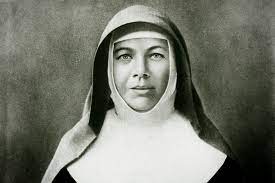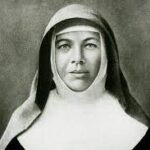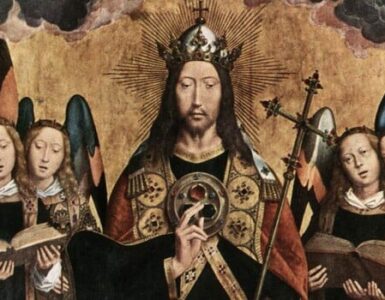St. Mary MacKillop was born in 1842 in South Australia to a poor family of Scots immigrants. Mary had to become the breadwinner at age 14, despite wanting to become a religious sister from the time of her First Communion.
In January 1864 St. Mary opened a Catholic girls’ school, employing her sister Maggie as a teacher and her mother as a housekeeper. In 1866, Mary moved to Penola with her sisters. Her brother John renovated a cottage and a stable into the first St. Joseph’s school. To the astonishment of the locals, the girls even taught children whose parents could not afford to pay. Together the siblings taught more than 50 local children.
But Mary still wanted to be a religious sister. She continued to teach, but a local parish priest, Fr. Julian Tenison Woods, drew up a rule for an order of religious sisters, and at age 26, Mary made the public vows of obedience, chastity, and poverty. The Bishop of Adelaide, Bishop Laurence Sheil approved the rule. Within two years, 70 Sisters of St. Joseph were teaching children at 21 schools in South Australia.
But as we show in our new book, Persecuted From Within, the sisters met with intense opposition from the Catholic clergy.
One Sister of St. Joseph accused an Irish priest of solicitation in the confessional, and he was sent back to Ireland. According to one Jesuit who knew St. Mary, this enraged the close circle of Irish clergy from which was taken nearly all of the bishops of Australia at the time. One Irish priest, a Fr. Charles Horan, reportedly “swore vengeance” on her.
Bishop Sheil went to Rome for the First Vatican Council. He came down with sunstroke, and came back a different man. The day after he arrived, he was presented with a document signed by Fr. Horan and by 10 other priests denouncing the Sisters. He believed it, and repeated its accusations to Mary. He informed her that he was turning over their house to the Dominicans and would examine all of the teaching sisters for competence.
Soon Father Horan informed the sisters that there would be some minor changes to the rule and that St. Mary was to go to St. John’s, some 40 miles away. Fr. Horan left and returned after 10 o’clock at night. He told a Sister Teresa to tell St. Mary that she would be excommunicated if she did not obey the bishop’s new constitution.
At 8 AM, the Bishop and four priests arrived, demanding to know why they had not attended mass. The sisters said that they thought they were excommunicated.
St. Mary was sick in bed with a migraine. The Bishop summoned her to the chapel. She asked for the bishop’s blessing. He refused. He ordered her to kneel before him. He scolded her for her “pride” and read the order of excommunication. The Bishop then threatened to do the same to any of the sisters who continued to have dealings with her.
As St. Mary obeyed the bishop and walked out of the church, all of the sisters followed her, some of them weeping. The Bishop then called them back and they each asked to be dispensed from their vows.
St. Mary moved in with the family of Fr. Woods’ brother James, who was a journalist. St. Mary made him promise “not to write one single word against the bishop and priests.” She gave the other sisters the same order to say nothing ill against the clergy.
The convent at Adelaide quickly emptied and Bishop Sheil refused to renew the lease. Many schools closed. Priests often refused to give the sisters communion. Many of the sisters took jobs in the city, working as servants, manual laborers, or governesses.
The excommunication was invalid. Nevertheless, St. Mary made no effort to clear her name. She considered this trial an opportunity to offer suffering to God.
When the saint did speak of the Bishop, it was with pity. “The poor bishop…there are some about him whom God permits to be bitterly opposed to Fr. Woods and in a manner to myself…our poor, dear old Bishop…”
The bishop’s health continued to decline, and the effect on his cognitive abilities became more obvious. But in February 1872, the bishop’s mind suddenly became clear again, and he realized the duplicity of his advisors. On February 23, the Bishop lifted the sentence on St. Mary. The Bishop then moved to ensure that Fr. Horan would not be administrator of the diocese after his death.
When the bishop died on March 1, the administrator, Fr. Christopher Reynolds, immediately accepted back all of the sisters, who prayed around Bishop Sheil’s casket all night.
St. Mary continued to think well of Bishop Sheil, referring to him as “our late and much loved bishop.” She not only forgave the priests; she went out of her way to excuse what they had done.
Unfortunately, this was not to be the end of St. Mary’s sufferings at the hands of bishops. But it became the most famous episode in her many examples of heroic obedience.
In 1995, Pope John Paul II beatified Mary MacKillop, and in 2009, Bishop Sheil’s successor, Archbishop Philip Wilson, publicly apologized to the Sisters of St. Joseph for St. Mary’s wrongful and invalid excommunication.
On October 17, 2010, Pope Benedict XVI canonized St. Mary Mackillop, the first Australian to be canonized.
This article was adapted from Alec’s new book, Persecuted from Within, which is available from Sophia Institute Press October 17, 2023.
Image credit: State Library of South Australia CC











